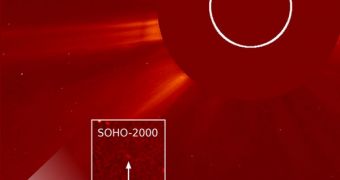On December 26, following more than 15 years of non-stop activity, a joint NASA/ESA mission managed to identify its 2,000th comet, while conducting its regular studies of the Sun.
The Solar and Heliospheric Observatory (SOHO) is operated by both NASA and the European Space Agency, and it has been observing the star since December 2, 1995, when it launched from the Cape Canaveral Air Force Station (CCAFS), in Florida.
Even though it was originally developed as a Sun-studying spacecraft, its operators, mission controllers, and amateur astronomers browsing through its data realized the the probe had another special skill, which was to identify comets.
Though no one had prepared to handle such data, SOHO continued to transmit them regardless. Over the years, it became the most prolific comet-finder of all times. On December 26, it reached the 2,000 mark, an achievement that again demonstrated its versatility.
“Since it launched on December 2, 1995, to observe the Sun, SOHO has more than doubled the number of comets for which orbits have been determined over the last 300 years,” explains Joe Gurman.
He is an an US project scientist for SOHO, who is based at the NASA Goddard Space Flight Center (GSFC), in Greenbelt, Maryland. The facility is in charge of managing the mission, Space reports.
The spacecraft itself does not look for comets on purpose. However, a small army of amateur astronomers volunteers to peer through the vast volumes of data that the telescope returns, in search for signs that may hint at the existence of the wandering celestial bodies.
About 70 people from 18 different countries are credited with helping the American space agency discover a very large number of comets over the last decade and a half.
“There are a lot of people who do it. They do it for free, they're extremely thorough, and if it wasn't for these people, most of this stuff would never see the light of day,” says Karl Battams.
He is the administrator of the SOHO comet-sighting website for the Naval Research Lab (NRL), in Washington, DC. The expert conducts computer processing for the SOHO cameras as well.
Due to the fact that increasing numbers of astronomers are participating in the work, it took SOHO some 5 years to discover comets 1,001 through 2,000. Discovering the first 1,000 comets took the first ten years of mission.
“[...] there is definitely a lot of science that comes with these comets. First, now we know there are far more comets in the inner solar system than we were previously aware of, and that can tell us a lot about where such things come from and how they're formed originally and break up,” Battams says.
“We can tell that a lot of these comets all have a common origin,” he concludes.

 14 DAY TRIAL //
14 DAY TRIAL //